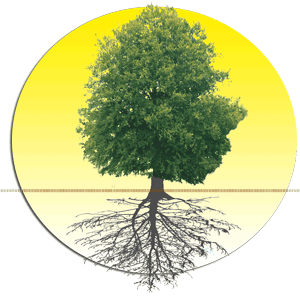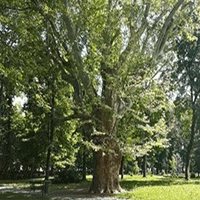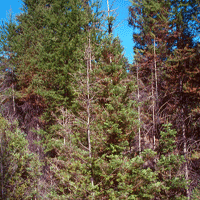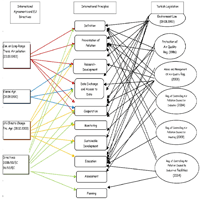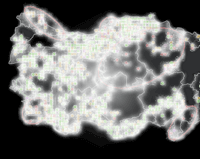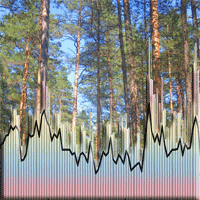Soil contamination by heavy metals is among the most serious danger for the environment, and new methods for its containment and removal are claimed, in particular for agricultural soils. Phytoremediation is an emerging, potentially effective technology applicable to restoration of contaminated soils and waters. Besides hyperaccumulator herbaceous plants, several woody species are now considered of interest to this aim. Many woody plants are fast growing, have deep roots, produce abundant biomass, are easy to harvest, and several species revealed some capacity to tolerate and accumulate heavy metals. Biotechnologies are now available for investigating this potential and enlarge the possibilities of exploitation of trees for remediation. The use of in vitro cultures, the role of bacteria and mychorrhizas, the powerful tool of genetic engineering, are some of the aspects focused in this paper that open prospects of global relevance for a better understanding of the processes related to the uptake of heavy metals by woody plants. In recent years significant progress has been made in identifying native plants and developing genetically modified tree plants for the remediation of heavy-metal polluted environment. Despite the intensive research developed in the last years, few field trials demonstrated the feasibility of the approach described, therefore much efforts should be addressed to this goal.
Keywords
, , , ,
Citation
Capuana M (2011). Heavy metals and woody plants - biotechnologies for phytoremediation. iForest 4: 7-15. - doi: 10.3832/ifor0555-004
Paper history
Received: Sep 01, 2010
Accepted: Nov 22, 2010
First online: Jan 27, 2011
Publication Date: Jan 27, 2011
Publication Time: 2.20 months
© SISEF - The Italian Society of Silviculture and Forest Ecology 2011
Open Access
This article is distributed under the terms of the Creative Commons Attribution-Non Commercial 4.0 International (https://creativecommons.org/licenses/by-nc/4.0/), which permits unrestricted use, distribution, and reproduction in any medium, provided you give appropriate credit to the original author(s) and the source, provide a link to the Creative Commons license, and indicate if changes were made.

Breakdown by View Type
(Waiting for server response...)
Article Usage
Total Article Views: 85258
(from publication date up to now)
Breakdown by View Type
HTML Page Views: 63725
Abstract Page Views: 8995
PDF Downloads: 10638
Citation/Reference Downloads: 103
XML Downloads: 1797
Web Metrics
Days since publication: 5433
Overall contacts: 85258
Avg. contacts per week: 109.85
Article Citations
Article citations are based on data periodically collected from the Clarivate Web of Science web site
(last update: Mar 2025)
Total number of cites (since 2011): 79
Average cites per year: 5.27
Publication Metrics
by Dimensions ©
Articles citing this article
List of the papers citing this article based on CrossRef Cited-by.
(1)
Adriaensen K, Vrålstad T, Noben JP, Vangronsveld J, Colpaert JV (2005)Copper adapted
Suillus luteus, a symbiotic solution for pines colonising Cu mine spoil. Applied and Environmental Microbiology 71: 7279-7284.
CrossRef |
Gscholar
(2)
Adriaensen K, Vangronsveld J, Colpaert JV (2006)Zinc-tolerant
Suillus bovinus improves growth of Zn-exposed
Pinus sylvestris seedlings. Mycorrhiza 16: 553-558.
CrossRef |
Gscholar
(3)
Arduini I, Godbold DL, Onnis A (1996)Cadmium and copper uptake and distribution in Mediterranean tree seedlings. Physiologia Plantarum 97: 111-117.
CrossRef |
Gscholar
(4)
Arisi ACM, Mocquot B, Lagriffoul A, Mench M, Foyer CH, Jouanin L (2001)Responses to cadmium in leaves of transformed poplars overexpressing Γ-glutamylcysteine synthetase.Physiologia Plantarum 109 (2):143 -149.
CrossRef |
Gscholar
(5)
Aronsson P, Perttu K (2001)Willow vegetation filters for wastewater treatment and soil remediation combined with biomass production. Forestry Chronicle 77: 293-299.
Gscholar
(6)
Arriagada C, Pereira G, García-Romera I, Ocampo JA (2010)Improved zinc tolerance in
Eucalyptus globulus inoculated with
Glomus deserticola and
Trametes versicolor or
Coriolopsis rigida. Soil Biology & Biochemistry 42: 118-1124.
CrossRef |
Gscholar
(7)
Audet P, Charest C (2007a)Heavy metal phytoremediation from a meta-analytical perspective. Environmental Pollution 147 (1): 231-237.
CrossRef |
Gscholar
(8)
Audet P, Charest C (2007b)Dynamics of Arbuscular mycorrhyzal symbiosis in heavy metal phytoremediation: Meta-analytical and conceptual perspectives. Environmental Pollution 147 (3): 609-614.
CrossRef |
Gscholar
(9)
Audet P, Charest C (2008)Allocation plasticity and plant-metal partitioning: Meta-analytical perspectives in phytoremediation. Environmental Pollution 156 (2): 290-296.
CrossRef |
Gscholar
(10)
Baker AJM, McGrath SP, Sidoli CMD, Reeves RD (1994)The possibility of
in situ heavy metal decontamination of polluted soils using crops of metal-accumulating plants. Resources, Conservation and Recycling 11: 41-49.
CrossRef |
Gscholar
(11)
Balestrazzi A, Botti S, Zelasco S, Biondi S, Franchin C, Calligari P, et al. (2009) . Expression of the PsMT
A1 gene in white poplar engineered with the MAT system is associated with heavy metal tolerance and protection against 8-hydroxy-2′-deoxyguanosine mediated-DNA damage. Plant Cell Reports 28: 1179-1192.
CrossRef |
Gscholar
(12)
Bañuelos GS, Shannon MC, Ajwa H, Draper JH, Jordahl J, Licht L (1999)Phytoextraction and accumulation of boron and selenium by poplar (
Populus) clones. International Journal of Phytoremediation 1: 81-96.
CrossRef |
Gscholar
(13)
Barceló J, Poschenrieder C (2003)Phytoremediation: principles and perspectives. Science 2 (3): 333-344.
Gscholar
(14)
Berndes G, Fredrikson F, Borjesson P (2004)Cadmium accumulation and
Salix-based phytoextraction on arable land in Sweden. Agriculture, Ecosystems & Environment 103: 207-223.
CrossRef |
Gscholar
(15)
Bissonnette L, St-Arnaud M, Labreque M (2010)Phytoextraction of heavy metals by two Salicaceae clones in symbiosis with arbuscular mycorrhizal fungi during the second year of a field trial. Plant and Soil 332: 55-67.
CrossRef |
Gscholar
(16)
Bittsanszky A, Komives T, Gullner G, Gyulai G, Kiss J, Heszky L, Radimszky L, Rennenberg H (2005)Ability of transgenic poplars with elevated glutathione content to tolerate zinc(2+) stress. Environment International 31: 251-254.
CrossRef |
Gscholar
(17)
Blaudez D, Jacob C, Turnau K, Colpaert JV, Ahonen-Jonnarth U, Finlay R, et al. (2000)Differential responses of ectomycorrhizal fungi to heavy metals
in vitro. Mycological Research 104: 1366-1371.
CrossRef |
Gscholar
(18)
Bojarczuk K, Kieliszewska-Rokicka B (2010)Effect of ectomycorrhiza on Cu and Pb accumulation in leaves and roots of silver birch (
Betula pendula Roth.) seedlings grown in metal-contaminated soil. Water, Air and Soil Pollution 207: 227-240.
CrossRef |
Gscholar
(19)
Borghi M, Tognetti R, Monteforti G, Sebastiani L (2007)Responses of
Populus x
euramericana (
P. deltoides x
P. nigra) clone
Adda to increasing copper concentrations. Environmental and Experimental Botany 61: 66-73.
CrossRef |
Gscholar
(20)
Bradshaw HD, Ceulemans R, Davis J, Stettler R (2000)Emerging model systems in plant biology: poplar (
Populus) as a model forest tree. Journal of Plant Growth Regulation 19: 306-313.
CrossRef |
Gscholar
(21)
Brunner I, Luster J, Günthardt-Goerg MS, Frey B (2008)Heavy metal accumulation and phytostabilisation potential of tree fine roots in a contaminated soil. Environmental Pollution 152 (3): 559-568.
CrossRef |
Gscholar
(22)
Burken JG, Schnoor JL (1998)Predictive relationships for uptake of organic contaminants by hybrid poplar trees. Environmental Science & Technology 32 (21): 3379-3385.
CrossRef |
Gscholar
(23)
Castiglione S, Franchin C, Fossati T, Lingua G, Torrigiani P, Biondi S (2007)High zinc concentrations reduce rooting capacity and alter metallothionein gene expression in white poplar (
Populus alba L. cv. Villafranca). Chemosphere 67 (6): 1117-1126.
CrossRef |
Gscholar
(24)
Chaney RL (1983)Plant uptake of inorganic waste constitutes In: “Land treatment of hazardous wastes” (Parr JF, Marsh PB, Kla JM eds). Noyes Data Corp., Park Ridge, USA, pp. 50-76.
Gscholar
(25)
Chaney RL, Angle JS, Broadhurst CL, Peters CA, Tappero RV, Sparks DL (2007)Improved understanding of hyperaccumulation yields commercial phytoextraction and phytomining technologies. Journal of Environmental Quality 36 (5): 1429-4143.
CrossRef |
Gscholar
(26)
Chaney WR, Strickland RC (1984)Relative toxicity of heavy metals to red pine pollen germination and germ tube elongation. Journal of Environmental Quality 13: 391-394.
CrossRef |
Gscholar
(27)
Chanway CP, Shishido M, Nairn J, Jungwirth S, Markham J, Xiao G, Holl FB (2000)Endophytic colonization and field responses of hybrid spruce seedlings after inoculation with plant growth-promoting rhizobacteria. Forest Ecology and Management 133: 81-88.
CrossRef |
Gscholar
(28)
Chanway CP, Holl FB (1994a)Growth of outplanted lodgepole pine seedlings one year after inoculation with plant growth promoting rhizobacteria. Forest Science 40 (2): 238-246.
Gscholar
(29)
Chanway CP, Holl FB (1994b)Ecological growth response specificity of two Douglas-fir ecotypes inoculated with coexistent beneficial rhizosphere bacteria. Canadian Journal of Botany 72 (5): 582-586.
CrossRef |
Gscholar
(30)
Che D, Meagher RB, Heaton ACP, Lima A, Rugh CL, Merkle SA (2003)Expression of mercuric ion reductase in Eastern cottonwood (
Populus deltoides) confers mercuric ion reduction and resistance. Plant Biotechnology Journal 1: 311.
CrossRef |
Gscholar
(31)
Cherian S, Oliveira MM (2005)Transgenic plants in phytoremediation: recent advances and new possibilities. Environmental Science & Technology 39: 9377-9390.
CrossRef |
Gscholar
(32)
Clemens S (2001)Molecular mechanisms of plant metal tolerance and homeostasis. Planta 212: 475-486.
CrossRef |
Gscholar
(33)
Clemens S, Palmgren MG, Kranmer U (2002)A long way ahead: understanding and engineering plant metal accumulation. Trends in Plant Science 7: 309-314.
CrossRef |
Gscholar
(34)
Cobbett C, Goldsbrough P (2002)Phytochelatins and metallothioneins: roles in heavy metal detoxification and homeostasis. Annual Review of Plant Biology 53: 159-182.
CrossRef |
Gscholar
(35)
Confalonieri M, Balestrazzi A, Bisoffi S, Carbonera D (2003) In vitro culture and genetic engineering of
Populus spp.: synergy for forest tree improvement. Plant Cell Tissue and Organ Culture 72: 109-138.
CrossRef |
Gscholar
(36)
Corseuil HX, Moreno FN (2001)Phytoremediation potential of willow trees for aquifers contaminated with ethanol-blended gasoline. Water Research 35 (12): 3013-3017.
CrossRef |
Gscholar
(37)
Cunningham SD, Berti WR, Huang JW (1995)Phytoremediation of contaminated soils. Trends in Biotechnology 13 (9): 393-397.
CrossRef |
Gscholar
(38)
Czako M, Feng X, He Y, Liang D, Marton L (2006)Transgenic
Spartina alterniflora for phytoremediation. Environmental Geochemistry and Health 28: 103-110.
CrossRef |
Gscholar
(39)
Davison J (2005)Risk mitigation of genetically modified bacteria and plants designed for bioremediation. Journal of Industrial Microbiology and Biotechnology 32: 639-650.
CrossRef |
Gscholar
(40)
Denny HJ, Wilkins DA (1987)Zinc tolerance in
Betula spp. IV. Mechanisms of ectomycorrhizal amelioration of zinc toxicity to higher plants. New Phytologist 106: 545-553.
Gscholar
(41)
Dhankher OP, Li Y, Rosen BP, Shi J, Salt D, Senecoff JF, Sashti NA, Meagher RB (2002)Engineering tolerance and hyperaccumulation of arsenic in plants by combining arsenate reductase and gamma-glutamylcysteine synthetase expression. Nature Biotechnology 20: 1140-1141.
CrossRef |
Gscholar
(42)
Di Baccio D, Tognetti R, Sebastiani L, Vitagliano C (2003)Responses of
Populus deltoides ×
Populus nigra (
Populus ×
euramericana) clone I-214 to high zinc concentrations. New Phytologist 159: 443-451.
CrossRef |
Gscholar
(43)
Di Baccio D, Kopriva S, Sebastiani L, Rennenberg H (2005)Does glutathione metabolism have a role in the defence of poplar against zinc excess? New Phytologist 167: 73-80.
CrossRef |
Gscholar
(44)
Dickinson NM, Pulford ID (2005)Cadmium phytoextraction using short-rotation coppice
Salix: The evidence trail. Environment International 31: 609-613.
CrossRef |
Gscholar
(45)
Dietz A, Schnoor JL (2001)Advances in phytoremediation. Environmental Health Perspectives 109: 163-168.
CrossRef |
Gscholar
(46)
Di Lonardo S, Capuana M, Arnetoli M, Gabbrielli R, Gonnelli C (2011)Exploring the metal phytoremediation potential of three
Populus alba L. clones using an in vitro screening. Environmental Science & Pollution Research 18: 82-90.
CrossRef |
Gscholar
(47)
Dix ME, Klopfenstein NB, Zhang JW, Workman SW, Kim MS (1997)Potential use of
Populus for phytoremediation of environmental pollution in riparian zones. In: “Micropropagation, genetic engineering, and molecular biology of
Populus” (Klopfenstein NB, Chun YW, Kim MS, Ahuja MR eds). Gen. Tech. Rep. RM-GTR-297, USDA Forest Service, pp. 206-211.
Gscholar
(48)
Domínguez MT, Marañón T, Murillo JM, Schulin R, Robinson BH (2008)Trace element accumulation in woody plants of the Guadiamar Valley, SW Spain: A large-scale phytomanagement case study. Environmental Pollution 152 (1): 50-59.
CrossRef |
Gscholar
(49)
Dos Santos Utmazian MN, Wieshammer G, Vega R, Wenzel WW (2007)Hydroponic screening for metal resistance and accumulation of cadmium and zinc in twenty clones of willows and poplars. Environmental Pollution 148: 155-165.
CrossRef |
Gscholar
(50)
Doty SL (2008)Enhancing phytoremediation through the use of transgenics and endophytes. New Phytologist 179: 318-333.
CrossRef |
Gscholar
(51)
Doty SL, Dosher MR, Singleton G, Moore AL, Van Aken B, Stettler RF, et al. (2005)Identification of an endophytic
Rhizobium in stems of
Populus. Symbiosis 39: 27-36.
Gscholar
(52)
Dudka S, Miller WP (1999)Accumulation of potentially toxic elements in plants and their transfer to human food chain. Journal of Environmental Science and Health 34 (4): 681-708.
CrossRef |
Gscholar
(53)
Eapen S, Suseelan K, Tivarekar S, Kotwal S, Mitra R (2003)Potential for rhizofiltration of uranium using hairy root cultures of
Brassica juncea and
Chenopodium amaranticolor. Environmental Research 91: 127-133.
CrossRef |
Gscholar
(54)
Eapen S, D’Souza SF (2005)Prospects of genetic engineering of plants for phytoremediation of toxic metals. Biotechnoligal Advances 23: 97-114.
CrossRef |
Gscholar
(55)
Ellis DR, Gumaelius L, Indriolo E, Pickering IJ, Banks JA, Salt DE (2006)A novel arsenate reductase from the arsenic hyperaccumulating fern
Pteris vittata. Plant Physiology 141: 1544-1554.
CrossRef |
Gscholar
(56)
Eriksson ME, Israelsson M, Olsson O, Moritz T (2000)Increased giberellin biosynthesis in transgenic trees promotes growth, biomass production and xylem fiber length. Nature Biotechnology 18: 784-788.
CrossRef |
Gscholar
(57)
Fernández R, Bertrand A, Casares A, García R, González A, Tamés RS (2008)Cadmium accumulation and its effect on the in vitro growth of woody fleabane and mycorrhized white birch. Environmental Pollution 152 (3): 522-529.
CrossRef |
Gscholar
(58)
Fischerová Z, Tlustos P., Szakova J, Sichorova K (2006)A comparison of phytoremediation capability of selected plant species for given trace elements. Environmental Pollution 144: 93-100.
CrossRef |
Gscholar
(59)
Franchin C, Fossati T, Pasquini E, Lingua G, Castiglione S, Torrigiani P (2007)High concentrations of Zn and Cu induce differential polyamine responses in micropropagated white poplar (
Populus alba L. ’Villafranca’), Physiologia Plantarum 130: 77-90.
CrossRef |
Gscholar
(60)
French CJ, Dickinson NM, Putwain PD (2006)Woody biomass phytoremediation of contaminated brownfield land. Environmental Pollution 141: 387-395.
CrossRef |
Gscholar
(61)
Frey B, Zierold K, Brunner I (2000)Extracellular complexation of Cd in the Hartig net and cytosolic Zn sequestration in the fungal mantle of
Picea abies-Hebeloma crustuliniforme ectomycorrhizas. Plant Cell & Environment 23: 1257-1265.
CrossRef |
Gscholar
(62)
Fulekar MH, Singh A, Bhaduri AM (2009)Genetic engineering strategies for enhancing phytoremediation of heavy metals. African Journal of Biotechnology 8 (4): 529-535.
Gscholar
(63)
Gatti E (2008)Micropropagation of
Ailanthus altissima and
in vitro heavy metal tolerance. Biologia Plantarum 52 (1): 146-148.
CrossRef |
Gscholar
(64)
Germaine K, Keogh E, Garcia-Cabellos G, Borremans B, van der Lelie D, Barac T, et al. (2004)Colonisation of poplar trees by
gfpexpressing bacterial endophytes. FEMS Microbiology Ecology 48: 109-118.
CrossRef |
Gscholar
(65)
Giachetti G, Sebastiani L (2006)Metal accumulation in poplar plant grown with industrial wastes. Chemosphere 64: 446-454.
CrossRef |
Gscholar
(66)
Glass DJ (2000)Economic potential of phytoremediation. In: “Phytoremediation of toxic metals, using plants to clean up the environment” (Raskin I, Ensley BD eds). John Wiley, New York, USA, pp. 15-31.
Gscholar
(67)
Golan-Goldhirsh A, Barazani O, Nepovim A, Soudek P, Smrcek S, Dufkova L, et al. (2004)Plant response to heavy metals and organic pollutants in cell culture and at whole plant level. Journal of Soils and Sediments 4 (2): 133-140.
CrossRef |
Gscholar
(68)
Göhre V, Paszkowski U (2006)Contribution of the arbuscular mycorrhizal symbiosis to heavy metal phytoremediation. Planta 223 (6): 1115-1122.
CrossRef |
Gscholar
(69)
Granel T, Robinson BH, Mills TM, Clothier BE, Green SR, Fung L (2002)Cadmium accumulation by willow clones used for conservation, stock fodder and phytoremediation. Australian Journal of Soil Research 40: 1331-1337.
CrossRef |
Gscholar
(70)
Greger M, Landberg T (1999)Use of willow in phytoextraction. International Journal of Phytoremediation 1: 115-123.
CrossRef |
Gscholar
(71)
Grill E, Winnacker EL, Zenk MH (1985)Phytochelatins, the principal heavy-metal complexing peptides of higher plants. Science 230: 674-676.
CrossRef |
Gscholar
(72)
Hall JL (2002)Cellular mechanisms for heavy metal detoxification and tolerance. Journal of Experimental Botany 366: 1-11.
CrossRef |
Gscholar
(73)
Hammer D, Kayser A, Keller C (2003)Phytoextraction of Cd and Zn with
Salix viminalis in field trials. Soil Use and Management 19: 187-192.
CrossRef |
Gscholar
(74)
Han KH, Meilan R, Ma C, Strauss SH (2000)An
Agrobacterium tumefaciens transformation protocol effective on a variety of cottonwood hybrids (genus
Populus). Plant Cell Reports 19: 315-320.
CrossRef |
Gscholar
(75)
Hansen D, Duda P, Zayed AM, Terry N (1998)Selenium removal by constructed wetlands: role of biological volatilization. Environmental Science & Technology 32: 591-597.
CrossRef |
Gscholar
(76)
Harada E, Choi YE, Tsuchisaka A, Obata H, Sano H (2001)Transgenic tobacco plants expressing a rice cysteine synthase gene are tolerant to toxic levels of cadmium. Journal of Plant Physiology 158: 655-661.
CrossRef |
Gscholar
(77)
Harms HH (1992) In vitro systems for studying phototoxicity and metabolic fate of pesticides and xenobiotics in plants. Pesticide Science 35: 277-281.
CrossRef |
Gscholar
(78)
Heaton ACP, Rugh CL, Kim T, Wang NJ, Meagher RB (2003)Toward detoxifying mercury-polluted aquatic sediments with rice genetically engineered for mercury resistance. Environmental Toxicology and Chemistry 22: 2940-2947.
CrossRef |
Gscholar
(79)
Heim A, Luster J, Brunner I, Frey B, Frossard E (1999)Effects of aluminium treatment on Norway spruce roots, aluminium binding forms, element distribution, and release of organic acids. Plant and Soil 216 (1/2): 103-116.
CrossRef |
Gscholar
(80)
Idris R, Trifonova R, Puschenreiter M, Wenzel WW, Sessitsch A (2004)Bacterial communities associated with flowering plants of the Ni hyperaccumulator
Thlaspi goesingense. Applied and Environmental Microbiology 70: 2667-277.
CrossRef |
Gscholar
(81)
Jensen JK, Holm PE, Nejrup J, Larsen MB, Borggaard OK (2009)The potential of willow for remediation of heavy metal polluted calcareous urban soils. Environmental Pollution 157: 931-937.
CrossRef |
Gscholar
(82)
Kalisová-Spirochová I, Puncochárová J, Kafka Z (2003)Accumulation of heavy metals by
in vitro cultures of plants. Water, Air and Soil Pollution 3: 269-276.
CrossRef |
Gscholar
(83)
Kärenlampi S, Schat H, Vangronsveld J, Verkleij JAC, Van der Lelie D, Mergeay M, et al. (2000)Genetic engineering in the improvement of plants for phytoremediation of metal polluted soils. Environmental Pollution 107: 225-231.
CrossRef |
Gscholar
(84)
Khan AG, Keuk C, Chaudhry TM, Khoo CS, Hayes WJ (2000)Role of plants, mycorrhizae and phytochelators in heavy metal contaminated land remediation. Chemosphere 41: 197-207.
CrossRef |
Gscholar
(85)
Kinnersely AM (1993)The role of phytochelates in plant growth and productivity. Plant Growth Regulation 12: 207-217.
CrossRef |
Gscholar
(86)
Klang-Westin E, Perrtu K (2002)Effects of nutrient supply and soil cadmium contamination on cadmium removal by willow. Biomass & Bioenergy 23: 415-426.
CrossRef |
Gscholar
(87)
Kloke A, Sauerbeck DR, Vetter H (1984)The contamination of plants and soils with heavy metals and the transport of metals in terrestrial food chains. In: “Changing metal cycles and human health” (Nriagu JO ed). Springer-Verlag, Berlin, pp. 113-119.
Gscholar
(88)
Kneer R, Zenk MH (1992)Phytochelatins protect plant enzymes from heavy metal poisoning. Phytochemistry 31: 2663-2667.
CrossRef |
Gscholar
(89)
Knowles LP, Adair A (2007)Genetic engineering in trees: the international legal landscape. Journal of Biolaw and Business 10 (4): 16-22.
Gscholar
(90)
Kohler A, Blaudez D, Chalot M, Martin F (2004)Cloning and expression of multiple metallothioneins from hybrid poplar. New Phytologist 164: 83-93.
CrossRef |
Gscholar
(91)
Kopponen P, Utriainen M, Lukkari K, Suntioinen S, Karenlampi L, Karenlampi S (2001)Clonal differences in copper and zinc tolerance of birch in metal-supplemented soils. Environmental Pollution 112: 89-97.
CrossRef |
Gscholar
(92)
Kozlov MV, Haukioja E, Bakhtiarov AV, Stroganov DN, Zimina SN (2000)Root versus canopy uptake of heavy metals by birch in an industrially polluted area: contrasting behaviour of nickel and copper. Environmental Pollution 107 (3): 413-420.
CrossRef |
Gscholar
(93)
Krämer U, Chardonnens AN (2001)The use of transgenic plants in the bioremediation of soils contaminated with trace elements. Applied Microbiology and Biotechnology 55: 661-72.
CrossRef |
Gscholar
(94)
Kuffner M, De Maria S, Puschenreiter M, Fallmann K, Wieshammer G, Gorfer M, et al. (2010)Culturable bacteria from Zn- and Cd- accumulating
Salix caprea with differential effects on plant growth and heavy metal availability. Journal of Applied Microbiology 108: 1471-1484.
CrossRef |
Gscholar
(95)
Kumar PBAN, Dushenkov V, Motto H, Raskin I (1995)Phytoextraction: The use of plants to remove heavy metals from soils. Environmental Science & Technology 29: 1232-1238.
CrossRef |
Gscholar
(96)
Kuzovkina YA, Knee M, Quigley MF (2004)Cadmium and copper uptake and translocation in five willow (
Salix L.) species. International Journal of Phytoremediation 6: 269-287.
CrossRef |
Gscholar
(97)
Labreque M, Teodorescu TI, Daigle S (1995)Effect of wastewater sludge on growth and heavy metal bioaccumulation of two
Salix species. Plant and Soil 171: 303-316.
CrossRef |
Gscholar
(98)
Lasat MM (2002)Phytoextraction of toxic metals: a review of biological mechanisms. Journal of Environmental Quality 31: 109-120.
CrossRef |
Gscholar
(99)
Laureysens I, Blust R, De Temmerman L, Lemmens C, Ceulemans R (2004a)Clonal variation in heavy metal accumulation and biomass production in a poplar coppice culture: I. Seasonal variation in leaf, wood and bark concentrations. Environmental Pollution 131 (3): 485-494.
CrossRef |
Gscholar
(100)
Laureysens I, Bogaert J, Blust R, Ceulemans R (2004b)Biomass production of 17 poplar clones in a short-rotation coppice culture on a waste disposal site and its relation to soil characteristics. Forest Ecology and Management 187 (2/3): 295-309.
CrossRef |
Gscholar
(101)
Lingua G, Castiglione S, Todeschini V, Franchin C, Fossati T, Peterson EA, et al. (2005)Selection of elite poplar clones for phytoremediation of soil contaminated by heavy metals in field and glass-house experiments. In: Proceedings of the “XVII International Botanical Congress”. Wien (Austria) 17-23 July 2005, pp. 624.
Gscholar
(102)
Lingua G, Franchin C, Todeschini V, Castiglione S, Biondi S, Burlando B, et al. (2008)Arbuscular mycorrhizal fungi differentially affect the response to high zinc concentrations of two registered poplar clones. Environmental Pollution 153: 147-157.
CrossRef |
Gscholar
(103)
Lodewyckx C, Taghavi S, Mergeay M, Vangronsveld J, Clijsters H, van der Lelie D (2001)The effect of recombinant heavy metal resistant endophytic bacteria in heavy metal uptake by their host plant. International Journal of Phytoremediation 3: 173-187.
CrossRef |
Gscholar
(104)
Lunácková L, Ottníková A, Masarovicová E, Lux A, Streko V (2003)Comparison of cadmium effect on willow and poplar in response to different cultivation conditions. Biologia Plantarum 47: 403-411.
CrossRef |
Gscholar
(105)
Lyyra S, Lima A, Merkle SA (2006) In vitro regeneration of
Salix nigra from adventitious shoots. Tree Physiology 26: 969-975.
Gscholar
(106)
Lyyra S, Meagher RB, Kim T, Heaton A, Montello P, Balish RS, Merkle SA (2007)Coupling two mercury resistance genes in Eastern cottonwood enhances the processing of organomercury. Plant Biotechnology Journal 5: 254-262.
CrossRef |
Gscholar
(107)
Macnair MR, Tilstone GH, Smith SE (2000)The genetics of metal tolerance and accumulation in higher plants. In: “Phytoremediation of contaminated soil and water” (Terry N, Bañuelos G eds). Lewis Publications, Boca Raton, FL, USA, pp. 235-250.
Gscholar
(108)
Madejou P, Maranon T, Murillo JM, Robinson B (2004)White poplar (
Populus alba) as a biomonitor of trace elements in contaminated riparian forests. Environmental Pollution 132: 145-155.
CrossRef |
Gscholar
(109)
Maitani Y, Kubota H, Sato K, Takeda M, Yoshihira K (1996)Induction of phytochelatin (class III metallothionein) and incorporation of copper in transformed hairy roots of
Rubia tinctorum exposed to cadmium. Journal of Plant Physiology 147: 743-748.
Gscholar
(110)
Marmiroli N, Marmiroli M, Maestri E (2006)Phytoremediation and phytotechnologies: a review for the present and the future. In: “Soil and water pollution monitoring, protection and remediation” (Twardowska I et al. eds). Springer, The Netherlands, pp. 3-23.
Gscholar
(111)
Martinez M, Bernal P, Almela C, Velez D, Garcia-Agustin P, Serrano R, Navarro-Avino J (2006)An engineered plant that accumulates higher levels of heavy metals than
Thlaspi caerulescens, with yields of 100 times more biomass in mine soils. Chemosphere 64: 478-485.
CrossRef |
Gscholar
(112)
Mastretta C, Taghavi S, van der Lelie D, Mengoni A, Galardi F, Gonnelli C, et al. (2009)Endophytic bacteria from seeds of
Nicotiana tabacum can reduce cadmium phytotoxicity. International Journal of Phytoremediation 11: 251-267.
CrossRef |
Gscholar
(113)
Maurice C, Lagerkvist A (2000)Using
Betula pendula and
Telephora caryophyllea for soil pollution assessment. Journal of Soil Contamination 9: 31-50.
CrossRef |
Gscholar
(114)
Meagher RB (2000)Phytoremediation of toxic elemental and organic pollutants. Current Opinion in Plant Biology 3: 153-162.
CrossRef |
Gscholar
(115)
McLaughlin MJ, Parker DR, Clarke JM (1999)Metals and micronutrients - food safety issues. Field Crops Research 60: 143-163.
CrossRef |
Gscholar
(116)
Meers E, Vandecasteele B, Ruttens A, Vangronsveld J, Tack FMG (2007)Potential of five willow species (
Salix spp.) for phytoextraction of heavy metals. Environmental and Experimental Botany 60: 57-68.
CrossRef |
Gscholar
(117)
Mehra RK, Tripathi RD (1999)Phytochelatins and metal tolerance. In: “Environmental pollution and plant responses” (Agrawal SB, Agrawal M eds). CRC Press, Lewis Publisher, Boca Raton, FL, USA, pp. 367-382.
Gscholar
(118)
Mezzari MP, Van Aken B, Yoon JM, Just CL, Schnoor JL (2004)Mathematical modeling of RDX and HMX metabolism in poplar (
Populus deltoides x
Populus nigra, DN34) tissue culture. International Journal of Phytoremediation 6: 323-345.
CrossRef |
Gscholar
(119)
Moore FP, Barac T, Borremans B, Oeyen L, Vangronsveld J, van der Lelie D, et al. (2006)Endophytic bacterial diversity in poplar trees growing on a BTEX-contaminated site: the characterisation of isolates with potential to enhance phytoremediation. Systematic and Applied Microbiology 29 (7): 539-556.
CrossRef |
Gscholar
(120)
Nedelkoska TV, Doran PM (2000)Characteristics of heavy metal uptake by plant species with potential for phytoremediation and phytomining. Minerals Engineering 13: 549
-561.
CrossRef |
Gscholar
(121)
Newman LA, Strand SE, Choe N, Duffy J, Ekuan G, Ruszaj M, et al. (1997)Uptake and biotransformation of trichloroethylene by hybrid poplars. Environmental Science & Technology 31: 1062-1067.
CrossRef |
Gscholar
(122)
Newman LA, Reynolds CM (2005)Bacteria and phytoremediation: new uses for endophytic bacteria in plants. Trends in Biotechnology 23: 6-8.
CrossRef |
Gscholar
(123)
Österås AH, Ekvall L, Greger M (2000)Sensitivity to, and accumulation of, cadmium in
Betula pendula,
Picea abies, and
Pinus sylvestris seedlings from different regions in Sweden. Canadian Journal of Botany 78 (11): 1440-1449.
CrossRef |
Gscholar
(124)
Padmavathiamma PK, Li LY (2007)Phytoremediation technology: hyper-accumulation metals in plants. Water, Air and Soil Pollution 184: 105-126.
CrossRef |
Gscholar
(125)
Paulson M, Bardos P, Harmsen J, Wilczek J, Barton M, Edwards D (2003)The practical use of short rotation coppice in land restoration. Land Contamination and Reclamation 11: 323-338.
CrossRef |
Gscholar
(126)
Pawloska TE, Charvat I (2004)Heavy-metal stress and developmental patterns of arbuscular mycorrhizal fungi. Applied and Environmental Microbiology 70 (11): 6643-6649.
CrossRef |
Gscholar
(127)
Peer WA, Baxter IR, Richards EL, Freeman JL, Murphy AS (2005)Phytoremediation and hyperaccumulator plants. In: “Molecular biology of metal homeostasis and detoxification, topics in current genetics” (Tamas M, Martinoia E eds). Vol. 14, Springer, Berlin, Germany, pp. 299-340.
Gscholar
(128)
Pilon M, Owen JD, Garifullina GF, Kurihara T, Mihara H, Esaki N, Pilon-Smits EAH (2003)Enhanced selenium tolerance and accumulation in transgenic Arabidopsis expressing a mouse selenocysteine lyase. Plant Physiology 131: 1250-1257.
CrossRef |
Gscholar
(129)
Pilon-Smith EAH, Freeman JL (2006)Environmental cleanup using plants: biotechnological advances and ecological considerations. Frontiers in Ecology and the Environment 4: 203-210.
CrossRef |
Gscholar
(130)
Pilon-Smits EAH, Pilon M (2002)Phytoremediation of metals using transgenic plants. Critical Revues in Plant Sciences 21: 439-456.
CrossRef |
Gscholar
(131)
Pisano SM, Rockwood DL (1997)Stormwater phytoremediation potential of
Eucalyptus. In: Proceedings of the “5
th Biennial Stormwater Research Conference”. Tampa (Florida, USA) 5-7 November 1997. Water Management District, Brooksville, FL, USA, pp. 32-42.
Gscholar
(132)
Prasad MNV, Freitas H (2000)Removal of toxic metals from the aqueous solution by the leaf, stem and root phytomass of
Quercus ilex L. (Holly Oak). Environmental Pollution 110 (2): 277-283.
CrossRef |
Gscholar
(133)
Prasad MNV (2003)Phytoremediation of metal-polluted ecosystems: hype for commercialization. Russian Journal of Plant Physiology 50: 686-700.
CrossRef |
Gscholar
(134)
Pulford ID, Watson C (2003)Phytoremediation of heavy metal-contaminated land by trees - A review. Environment International 29: 529-540.
CrossRef |
Gscholar
(135)
Pulford ID, Dickinson NM (2005)Phytoremediation technologies using trees. In: “Trace elements in the environment” (Prasad MNV, Saiwan KS, Naidu R eds). Taylor and Francis, CRC Press, New York, USA, pp. 375-395.
Gscholar
(136)
Punshon T, Dickinson NM (1999)Heavy metal resistance and accumulation characteristics in willows. Internationl Journal of Phytoremediation 1: 361-385.
CrossRef |
Gscholar
(137)
Puschenreiter M, Horak O, Friesl W, Hartl W (2005)Low-cost agricultural measures to reduce heavy metal transfer into food chain-a review. Plant, Soil and Environment 51: 1-11.
Gscholar
(138)
Rajkumar M, Ae N, Freitas H (2009)Endophytic bacteria and their potential to enhance heavy metal phytoextraction. Chemosphere 77(2): 153-160.
CrossRef |
Gscholar
(139)
Raskin I, Smith RD, Salt DE (1997)Phytoremediation of metals: using plants to remove pollutants from the environment. Current Opinion in Biotechnology 8: 221-226.
CrossRef |
Gscholar
(140)
Rathinasabapathi B, Wu S, Sundaram S, Rivoal J, Srivastava M, Ma LQ (2006)Arsenic resistance in
Pteris vittata L.: identification of a cytosolic triosephosphate isomerase based on cDNA expression cloning in
Escherichia coli. Plant Molecular Biology 62: 845-857.
CrossRef |
Gscholar
(141)
Rauser WE, Muwly P (1995)Retention of cadmium in roots of maize seedlings. Role of complexation by phytochelatins and related thiol peptides. Plant Physiology 109: 195-202.
CrossRef |
Gscholar
(142)
Reeves RD (1992)The hyperaccumulation of nickel by serpentine plants. In: “The vegetation of ultramafic (Serpentine) soils” (Baker AJM, Proctor J, Reeves RD eds). Intercept Ltd, Andover, UK, pp. 253-277.
Gscholar
(143)
Renzoni A, Zino F, Franchi E (1998)Mercury levels along the food chain and risk for exposed populations. Environmental Research 77(2): 68-72.
CrossRef |
Gscholar
(144)
Riddell-Black D (1994)Heavy metal uptake by fast growing willow species. In: “Willow vegetation filters for municipal wastewaters and sludges” (Aronsson P, Perttu K eds). Report no. 50, Sveriges Lantbruksuniversitet, Uppsala, pp. 145-151.
Gscholar
(145)
Robinson BH, Mills TM, Petit D, Fung LE, Green S, Clothier B, et al. (2000)Natural and induced cadmium-accumulation in poplar and willow: Implications for phytoremediation. Plant and Soil 227: 301-306.
CrossRef |
Gscholar
(146)
Robinson BH, Mills T, Green S, Chancerel B, Clothier B, Fung L, et al. (2005)Trace element accumulation by poplars and willows used for stock fodder. New Zealand Journal of Agricultural Research 48: 489-497.
CrossRef |
Gscholar
(147)
Rockwood DL, Naidu CV, Carter DR, Rahmani M, Spriggs TA, Lin C, et al. (2004)Short-rotation woody crops and phytoremediation: Opportunities for agroforestry? Agroforestry Systems 61: 51-63.
CrossRef |
Gscholar
(148)
Rosselli W, Keller C, Boschi K (2003)Phytoextraction capacity of trees growing on a metal contaminated soil. Plant and Soil 256: 265-272.
CrossRef |
Gscholar
(149)
Rugh CL (2004)Genetically engineered phytoremediation: one man’s trash is another man’s transgene. Trends in Biotechnology 22: 496-498.
CrossRef |
Gscholar
(150)
Rugh CL, Senecoff JF, Meagher RB, Merkle SA (1998)Development of transgenic yellow poplar for mercury phytoremediation. Nature Biotechnology 16: 925-928.
CrossRef |
Gscholar
(151)
Rugh CL, Wilde D, Stack NM, Thompson DM, Summers AO, Meagher RB (1996)Mercuric ion reduction and resistance in transgenic Arabidopsis thaliana plants expressing a modified bacterial merA gene. Proceedings of the National Academy of Science 93: 3182-3187.
CrossRef |
Gscholar
(152)
Salt DE, Blaylock M, Nanda Kumar PBA, Dushenkov V, Ensley BD, Chet I, Raskin I (1995)Phytoremediation: a novel strategy for the removal of toxic metals from the environment using plants
. Biotechnology 13: 468-474.
CrossRef |
Gscholar
(153)
Salt DE, Smith RD, Raskin I (1998)Phytoremediation. Annual Review of Plant Physiology and Plant Molecular Biology 49: 643-668.
CrossRef |
Gscholar
(154)
Scarascia-Mugnozza G, Ceulemans R, Heilman PE, Isebrands JG, Stettler RF, Hinckley TM (1997)Production physiology and morphology of
Populus species and their hybrids grown under short rotation. II. Biomass components and harvest index of hybrid and parental species clones. Canadian Journal of Forest Research 27: 285-294.
CrossRef |
Gscholar
(155)
Schat H, Llugany M, Vooijs R, Hartley-Whitaker J. Bleeker PM (2002)The role of phytochelatins in constitutive and adaptive heavy metal tolerances in hyperaccumulator and non-hyperaccumulator metallophytes. Journal of Experimental Botany 53: 1-12.
CrossRef |
Gscholar
(156)
Schnoor JL (2000)Phytostabilization of metals using hybrid poplar trees. In: “Phytoremediation of toxic metals, using plants to clean uup the environment” (Raskin I, Ensley BD eds). John Wiley, New York, USA, pp. 133-150.
Gscholar
(157)
Schützendübel A, Polle A (2002)Plant responses to abiotic stresses: heavy metal-induced oxidative stress and protection by mycorrhization. Journal of Experimantal Botany 53: 1351-1365.
CrossRef |
Gscholar
(158)
Schwambach J, Fadanelli C, Fett-Neto AG (2005)Mineral nutrition and adventitious rooting in microcuttings of
Eucalyptus globulus. Tree Physiology 25: 487-494.
Gscholar
(159)
Sebastiani L, Scebba F, Tognetti R (2004)Heavy metal accumulation and growth responses in poplar clones Eridano (
Populus deltoides ×
maximowiczii) and I-214 (
P. ×
euramericana) exposed to industrial waste. Environmental and Experimental Botany 52: 79-88.
CrossRef |
Gscholar
(160)
Selosse MA, Baudoin E, Vandenkoornhuyse P (2004)Symbiotic microorganisms, a key for ecological success and protection of plants. Comptes Rendus Biologies 327: 639-648.
CrossRef |
Gscholar
(161)
Shah K, Nongkynrih J (2007)Metal hyperaccumulation and bioremediation. Biologia Plantarum 51 (4): 618-634.
CrossRef |
Gscholar
(162)
Shim H, Chauhan S, Ryoo D, Bowers K, Thomas SM, Canada KA, et al. (2000)Rhizosphere competitiveness of trichloroethylene-degrading, poplar-colonizing recombinant bacteria. Applied and Environmental Microbiology 66: 4673-4678.
CrossRef |
Gscholar
(163)
Silver S (1996)Bacterial resistances to toxic metal ions - a review. Gene 179: 9-19.
CrossRef |
Gscholar
(164)
Silver S, Phung LT (2005)A bacterial view of the periodic table: genes and proteins for toxic inorganic ions. Journal of Industrial Microbiology and Biotechnology 32: 587-605.
CrossRef |
Gscholar
(165)
Song WY, Sohn EJ, Martinoia E, Lee YJ, Yang YY, Jasinski M, et al. (2003)Engineering tolerance and accumulation of lead and cadmium in transgenic plants. Nature Biotechnology 21: 914-919.
CrossRef |
Gscholar
(166)
Šottníková A, Lunácková L, Masarovicová E, Lux A, Streško V (2003)Changes in the rooting and growth of willow and poplars induced by cadmium. Biologia Plantarum 46: 129-131.
CrossRef |
Gscholar
(167)
Suresh B, Ravishankar GA (2004)Phytoremediation - A novel a promising approach for environmental clean-up. Critical Revues in Biotechnology 24: 97-124.
CrossRef |
Gscholar
(168)
Taghavi S, Barac T, Greenberg B, Borremans B, Vangronsveld J, van der Lelie D (2005)Horizontal gene transfer to endogenous endophytic bacteria from poplar improves phytoremediation of toluene. Applied and Environmental Microbiology 71: 8500-8505.
CrossRef |
Gscholar
(169)
Thompson PL, Ramer LA, Schnoor JL (1998)Uptake and transformation of TNT by hybrid poplar trees. Environmental Science & Technology 32: 975-980.
CrossRef |
Gscholar
(170)
Todeschini V, Franchin C, Castiglione S, Burlando B, Biondi S, Torrigiani P, et al. (2007)Responses of two registered poplar clones to copper, after inoculation, or not, with arbuscular mycorrhizal fungi. Caryologia 60: 146-155.
Gscholar
(171)
Trotta A, Falaschi P, Cornara L, Minganti V, Fusconi A, Drava G, Berta G (2006)Arbuscular mycorrhizae increase the arsenic translocation factor in the As hyperaccumulating fern
Pteris vittata L. Chemosphere 65: 74-81.
CrossRef |
Gscholar
(172)
Tuskan GA, Di Fazio S, Jansson S, Bohlmann J, Grigoriev I, Hellsten U, et al. (2006)The genome of black cottonwood, Populus trichocarpa (Torr. & Gray). Science 313: 1596-1604.
CrossRef |
Gscholar
(173)
Unterbrunner R, Puschenreiter M, Sommer P, Wieshammer G, Tlustos P, Zupan M, et al. (2007)Heavy metal accumulation in tree growing on contaminated sites in Central Europe. Environmental Pollution 148: 107-114.
CrossRef |
Gscholar
(174)
Utriainen MA, Kärenlampi LV, Kärenlampi SO, Schat H (1997)Differential tolerance to copper and zinc of micropropagated birches tested in hydroponics. New Phytologist 137: 543-549.
CrossRef |
Gscholar
(175)
Van Aken B, Peres CM, Doty SL, Yoon JM, Schnoor JL (2004a) Methylobacterium populi sp. nov., a novel aerobic, pink-pigmented, facultatively methylotrophic, methane-utilizing bacterium isolated from poplar trees (
Populus deltoids ×
nigra DN34). International Journal of Systematic and Evolutionary Microbiology 54: 1191-1196.
CrossRef |
Gscholar
(176)
Van Aken B, Yoon JM, Schnoor JL (2004b)Biodegradation of nitro-substituted explosives 2.4.6-trinitrotoluene, hexahydro-1.3.5-trinitro-1.3.5-triazine, and octahydro-1.3.5.7-tetranitro-1.3.5-tetrazocine by a phytosymbiotic
Methylobacteriumsp. associated with poplar tissues (
Populus deltoides×
nigra DN34). Applied and Environmental Microbiology 70: 508-517.
CrossRef |
Gscholar
(177)
Van Nevel L, Mertens J, Oorts K, Verheyen K (2007)Phytoextraction of metals from soils: How far from practice. Environmental Pollution 150 (1): 34-40.
CrossRef |
Gscholar
(178)
Vervaeke P, Luyssaert S, Mertens J, Meers E, Tack FMG, Lust N (2003)Phytoremediation prospects of willow stands on contaminated sediment: a field trial. Environmental Pollution 126: 275-282.
CrossRef |
Gscholar
(179)
Vyslouzilová M, Tlustoš P, Száková J, Pavlíková D (2003)As, Cd, Pb and Zn uptake by
Salix spp. clones grown in soils enriched by high loads of these elements. Plant, Soil and Environment 49: 191-196.
Gscholar
(180)
Wang Y, Greger M (2004)Clonal differences in mercury tolerance, accumulation, and distribution in willow. Journal of Environmental Quality 33 (5): 1779-1785.
CrossRef |
Gscholar
(181)
Watmough SA, Dickinson NM (1995)Multiple metal resistance and co-resistance in
Acer pseudoplatanus L. (sycamore) callus cultures. Annals of Botany 76: 465-472.
CrossRef |
Gscholar
(182)
Watmough SA, Hutchinson TC (1998)Relationship between soil metal contamination and metal resistance of callus established from mature red maple. Canadian Journal of Forest Research 28 (7): 1073-1077.
CrossRef |
Gscholar
(183)
Watson C, Pulford ID, Riddell-Black D (1999)Heavy metal toxicity responses of two willow (Salix) varieties grown hydroponically: development of a tolerance screening test. Environmental Geochemistry and Health 21: 359-364.
CrossRef |
Gscholar
(184)
Watson C, Pulford ID, Riddell-Black D (2003)Screening of willow species for resistance to heavy metals: Comparison of performance in a hydroponics system and field trials. International Journal of Phytoremediation 5: 351-365.
Gscholar
(185)
Wieshammer G, Unterbrunner R, Garcia TB, Zivkovic MF, Puschenreiter M, Wenzel WW (2007)Phytoextraction of Cd and Zn from agricultural soils by
Salix spp. and intercropping of
Salix caprea and
Arabidopsis halleri. Plant and Soil 298: 255-264.
CrossRef |
Gscholar
(186)
Witters N, Van Slycken S, Ruttens A, Adriaensen K, Meers E, Meiresonne L, et al. (2009)Short-rotation coppice of willow for phytoremediation of a metal-contaminated agricultural area: a sustainability assessment. BioEnergy Research 2 (3): 144-152.
CrossRef |
Gscholar
(187)
Yang X, Feng Y, He Z, Stoffella PJ (2005)Molecular mechanisms of heavy metal hyperaccumulation and phytoremediation. Journal of Trace Elements in Medicine and Biology 18: 339-353.
CrossRef |
Gscholar
(188)
Yoon JM, Van Aken B, Schnoor JL (2006)Leaching of contaminated leaves following uptake and phytoremediation of RDX, HMX, and TNT by poplar. International Journal of Phytoremediation 8 (1): 81-94.
CrossRef |
Gscholar
(189)
Zacchini M, Pietrini F, Scarascia Mugnozza G, Iori V, Pietrosanti L, Massacci A (2009)Metal tolerance, accumulation and translocation in poplar and willow clones treated with cadmium in hydroponics. Water, Air and Soil Pollution 197: 23-34.
CrossRef |
Gscholar
(190)
Zhu YG, Rosen BP (2009)Perspectives for genetic engineering for the phytoremediation of arsenic-contaminated environments: from imagination to reality? Current Opinion in Biotechnology 20: 220-224.
CrossRef |
Gscholar
